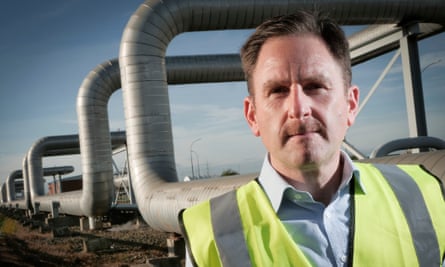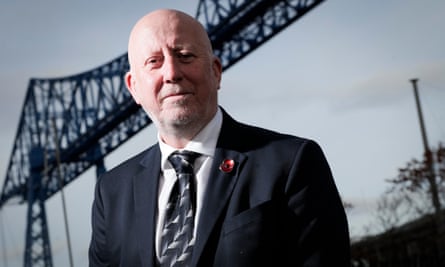There is demolition work at every turn on Teesside, from the increasingly regular explosions heard across Redcar, as the old steelworks is blasted to pieces, to the cranes taking down nearby Wilton International’s coal-fired power plant.
“The site has seen better days,” said Andy Koss of Sembcorp Industries, which manages the Wilton International complex. “For the region as a whole it has been a tough time, with the gradual erosion of industry at Wilton. And then the closure of the steelworks was a massive blow.”
On what is Europe’s largest brownfield site, work is gathering pace as Teesside prepares for the launch of the government’s new freeport, with hopes that the designation as a low-tax special economic zone will reboot the local economy.
With 11 sites planned across the UK, offering tax breaks and streamlined customs for businesses, freeports are a pet project for Rishi Sunak; the chancellor is selling them as a key advantage of Brexit and central to the Tories’ “levelling-up” agenda.
For the first of the sites to open – Teesside, Humber and Thames – tax cuts worth millions of pounds will be enabled by legislation on Friday. However, the jury is still out on whether freeports will generate the boost the chancellor promises.
On Teesside, there are hopes for as many as 18,000 new jobs, alongside benefits for the economy worth £3.2bn over the coming years. At Wilton, according to Koss, the looming launch date had brought a flurry of interest. “We are getting lots of inquiries. Every plot of land we can develop here has at least one inquiry,” he said. “Some have more than one.”

Sembcorp, headquartered in Singapore and a listed firm half-owned by the Singapore wealth fund, is now managing 562 acres of development land. It is available to businesses Sembcorp hopes will be lured by the tax breaks and by cheap electricity to be produced on site by four generators, amid ambitions to turn Wilton into a green industrial hub.
Central to the Teesside freeport project is the Conservative mayor of the Tees Valley, Ben Houchen, a rising star of the party who has caught national media attention for his “red wall” brand of interventionist Toryism. Vast swaths of land on the freeport site are under public control, and overseen by Houchen.
He intervened this year to buy the local airport and keep it open, and has a bid in for Teesport itself, amid a sale process of PD Ports, the current operator which is owned by Brookfield Asset Management.
This idea of bringing the public sector and private enterprise together represents a tussle at the heart of modern Toryism, as a model both of Thatcherite low-tax dogma and of state interventionism. Singapore on Tees, with central planning.
Under the freeport model, imports will be exempt from customs duties, but experts believe the more powerful incentive is a plethora of tax reliefs, that will be available on a site of up to 600 hectares in size within the special economic zone. From this week, there will be reliefs on business rates and stamp duty, and enhanced capital allowances to encourage building work and investment. There is also relief on national insurance contributions for staff employed in the zone, to spur job creation.
On Teesside, the outer boundary of the freeport will stretch for 45km, encompassing Middlesbrough, Stockton-on-Tees, Hartlepool and Redcar, as well as swaths of Tees valley countryside, including Houchen’s home town of Yarm.
Although readily available for photo opportunities in hard hat and high-vis when visiting Tories – including Boris Johnson – come to town, the mayor declined to be interviewed.

Andy McDonald, Labour MP for Middlesbrough, worries that for all this promise, Teesside’s freeport will bring little benefit for local workers.
“Hard hats and promises go a long way. Whether that translates into real meaningful employment and greater prosperity for all is another question altogether,” he said.
The former shadow employment rights secretary, who resigned from Keir Starmer’s frontbench last month, said Houchen had refused to meet him to discuss how workers’ rights could be protected. Trade unions will not be represented on the boards of the freeport, and McDonald is worried about a lack of transparency and appropriate direction in the mayor’s use of public funds.
“I want 18,000 new jobs, no two ways about it. But I want them to be good, well-paid, secure and unionised jobs, where people have got a say about their own future. We’re not going to get it with this. It’s ‘you will get the crumbs off our table’ stuff,” he said.
Touted by the government as a Brexit benefit, freeports are in reality nothing new. Seven sites operated under the status across the UK between 1984 and 2012, including at locations picked once more by the government for its new flagship project, such as Liverpool and Southampton.
More than 70 still operate in 20 EU member states – including in Barcelona, Bremerhaven and Venice. However, MEPs have recommended ending freeports within the bloc, warning of the risks of money laundering and tax evasion.
Concerns that freeports will do little for the UK economy appear to be borne out by historical and international evidence. In a potential sign of their limited scope, Treasury estimates suggest the exchequer will lose just £50m a year as a result of companies taking up freeport tax breaks.
The Office for Budget Responsibility, the government’s tax and spending watchdog, reckons there will be few meaningful benefits. The most likely outcome, it says, is that economic activity that would have taken place anyway is dragged from one area to another – with an added cost to taxpayers.
For some freeport advocates, this is entirely the point – to drag activity to poorer parts of the country. However, Peter Holmes of the UK Trade Policy Observatory at Sussex University, said it was unlikely to come at the cost of wealthier UK cities.
“If you take somewhere like Teesside, it’s obviously going to be at the expense of Tyneside,” he said. “Some of the places they’ve given freeport status to are clearly not going to be drawing away from richer areas. I came to the conclusion that they will be a complete anticlimax.”

Lewis Atter of the infrastructure advisory group at KPMG, who advised on the creation of the Humber freeport, thinks the benefits will be bigger than the Treasury’s internal estimates. He believes hundreds of millions of pounds could be saved by companies, with a genuine levelling-up boost in the process.
“We’re definitely seeing internationally mobile investors – not yet signed on the dotted line but close – linked to tax sites,” he said. “And people have only become interested in these since the announcement [on freeports]. It’s quite clear we are seeing genuinely additional investment.”
On Teesside there are hopes the critics could be proved wrong – especially after early progress was made with General Electric announcing plans to open a new offshore wind turbine manufacturing facility within the freeport. Dedicated to the production of 107-metre blades for the Dogger Bank windfarm – about 100 miles off the North Yorkshire coast and due to be the word’s largest upon completion in 2026 – the plant could create 750 direct renewable energy jobs and close to 1,500 indirect jobs in the area.
At Wilton International, Koss acknowledges that the freeport model might come with risks. However, it nonetheless stands as an opportunity in an area where the promise of a new beginning will be leapt upon.
“It’s great to have a focal point around which everybody can coalesce, and everybody understands what you’re trying to do. The starting gun has been fired. It’s great to see the Treasury have approved that, and we’ve now got to get out there.”
Neil O’Brien, the minister for levelling up, said: “Freeports will help to generate prosperity and spread opportunity by driving trade and innovation as we level up across the United Kingdom.”
This article was amended on 15 November 2021 to add a comment from Neil O’Brien
Freeports around the UK
East Midlands Airport The UK’s only inland freeport, located close to Derby and Nottingham, will include three sites with East Midlands airport at its heart. A new rail freight interchange next to the Toyota factory is planned, while the Ratcliffe-on-Soar coal-fired power station – one of three remaining in Britain, due to close in 2024 – is included as a site to be redeveloped.
Felixstowe and Harwich Known as Freeport East, it includes Britain’s busiest container port and two major ferry ports. Felixstowe has been among the most jammed up ports in the world during the supply chain chaos this autumn, with severe backlogs and stacked up containers. Planners aim to create 13,500 new jobs and an economic boost worth £5.5bn over 10 years. However, the site’s new Gateway 14 industrial park has drawn swathes of objections from local residents.
Humber Comprising the four ports of Hull, Goole, Immingham and Grimsby. With the area already a hub for offshore wind, the freeport will also include low-carbon energy projects, chemical works and rare earth minerals processing; key for batteries used in electric vehicles. A tax site will be located next to Siemens’ rail factory in Goole, which is currently under construction.
Liverpool City Region The freeport at the UK’s main transatlantic docks will stretch inland to the port of Salford, at the end of the Manchester ship canal. The plan includes three low-tax zones: The 3MG Mersey Multimodal Gateway at Widnes - birthplace of the chemicals industry – the Wirral Waters regeneration area, and the former Parkside colliery near St Helens, where a freight hub has been planned for more than a decade.
Plymouth Former Ministry of Defence docklands, used by the Royal Navy for centuries, will be redeveloped under the plan. Local planners hope to use three sites – Devonport South Yard, Langage Energy Zone and Sherford Business Park – to focus on marine and defence innovation, manufacturing and light processing, warehousing and staged imports.
Solent Taking in the ports of Southampton, Portsmouth and most of the Isle of Wight, the freeport planners hope to build on the area’s advantages in proximity to international shipping lanes on the English Channel. With Southampton the busiest export port for vehicles, stronger freight links to industrial heartlands in the midlands and north are planned.
Thames Although pitched as a way to boost regional growth away from London, the capital will have a freeport on the Thames. London Gateway and Tilbury ports will have tax zones, as will Ford’s Dagenham engine plant on the banks of the river. The emphasis will be on introducing electric and autonomous vehicle technology along the A13 corridor into London.
Scotland, Wales and Northern Ireland A freeport is planned in each of Scotland, Wales and Northern Ireland. However, progress has been slow amid disputes between Westminster and the devolved administrations. The Scottish government wants a “green port” model, including rules forcing businesses to pay the real living wage within them, but has faced difficulties with the Treasury. The Welsh government has similar plans, and faced similar issues. The Treasury said it remains committed to establishing freeports in each nation and region.
